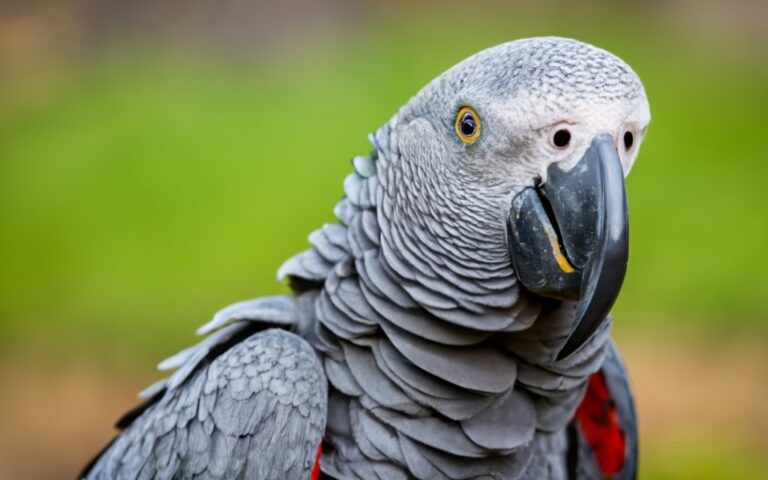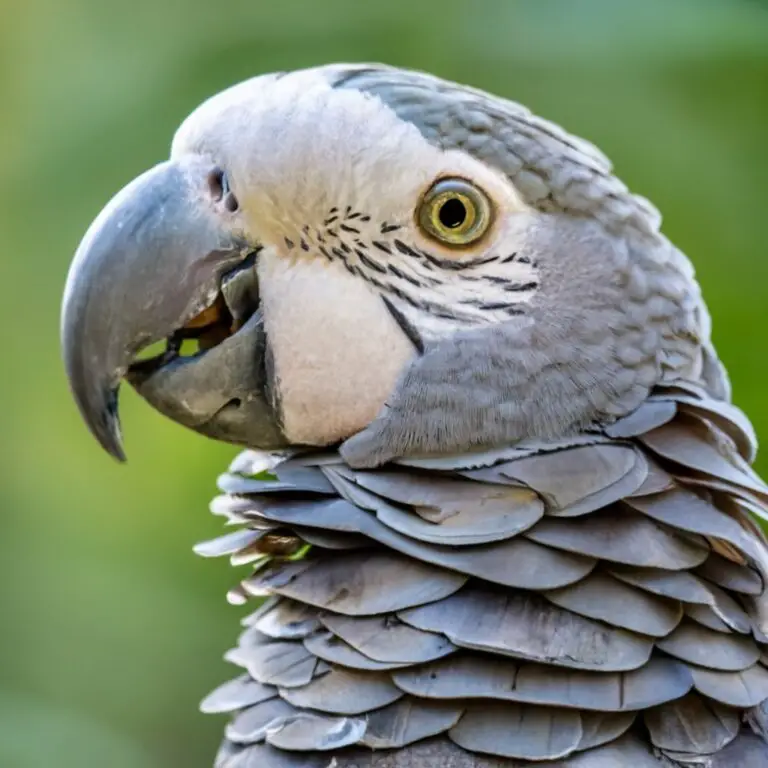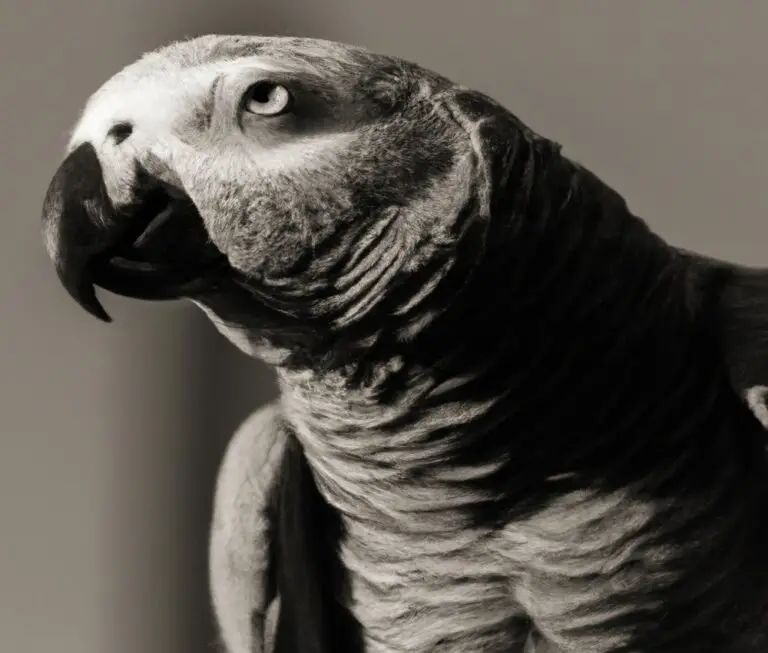How Can I Train My African Grey Parrot To Talk?
Key Takeaways:
- Start training your African Grey Parrot at a young age.
- Use positive reinforcement to encourage desired speech.
- Practice consistency and repetition in training sessions.
- Provide a stimulating environment to promote language development.
Are you dreaming of having a parrot that can hold meaningful conversations with you? Well, look no further than the African Grey Parrot! Their exceptional intelligence and ability to mimic sounds make them one of the best birds for talking training.
But how can you train your African Grey Parrot to talk?
In this article, I’ll guide you through the process of creating a positive environment for training, building a foundation for talking training, using effective techniques to teach words and phrases, troubleshooting common issues, enriching your parrot’s vocabulary, and maintaining and reinforcing their talking skills. Get ready to embark on an exciting journey of language learning with your African Grey Parrot!
| Methods | Pros | Cons |
| Repetition and Reward | – Effective method – Positive reinforcement – Builds a bond with your parrot | – Requires time and patience – Results may vary – May need professional guidance |
| Audio Training | – Helps parrot learn specific words – Can be done at any time | – May not mimic owner’s voice – May pick up unrelated sounds |
| Target Training | – Enhances parrot’s focus – Can be used to teach multiple tricks | – Can be time-consuming – Requires clicker or target stick |
| Environmental Enrichment | – Keeps the parrot mentally stimulated – Reduces boredom | – Not directly focused on talking – Additional training may be needed |
Understanding African Grey Parrots
African Grey Parrots are highly intelligent and social birds.
They have a reputation for their exceptional ability to mimic and talk.
Characteristics of African Grey Parrots
African Grey Parrots are known for their intelligence and ability to mimic human speech. These birds have a striking gray plumage, with a red tail in the Congo subspecies and a maroon tail in the Timneh subspecies.
They possess a large, powerful beak, ideal for cracking nuts and seeds.
African Grey Parrots are highly social and thrive on interaction and mental stimulation. They require a balanced diet consisting of high-quality pellets, fresh fruits, vegetables, and nuts.
Providing them with a spacious cage and plenty of toys is essential for their well-being.
Regular socialization and training can help them develop their talking abilities. So be patient and consistent in your efforts to train your African Grey Parrot to talk!
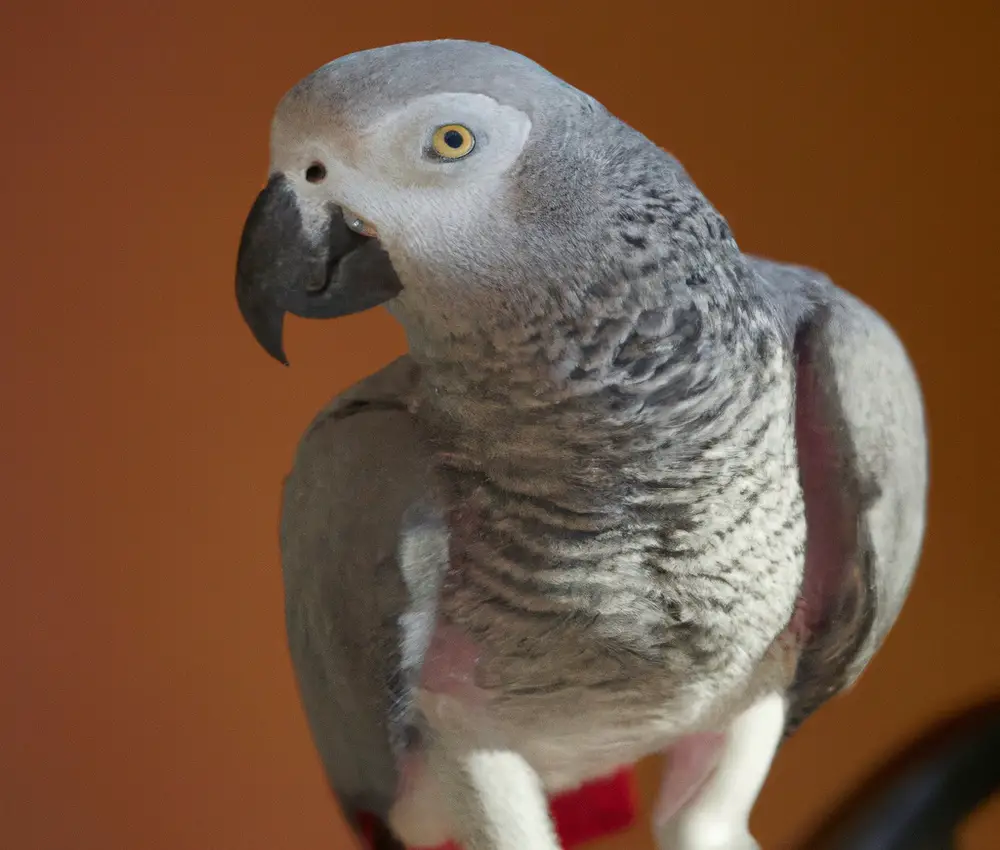
Vocal Abilities of African Grey Parrots
African Grey Parrots are known for their exceptional vocal abilities.
They have the capability to mimic and reproduce various sounds, including human speech.
These parrots can learn a wide range of words, phrases, and even entire conversations.
They can also mimic sounds like sirens, phones, and laughter.
Training techniques, consistency, and patience are key when teaching an African Grey Parrot to talk.
Providing a stimulating environment with plenty of social interaction can further enhance their speaking skills.

Common Challenges in Training African Grey Parrots to Talk
Training African Grey Parrots to talk can be a challenging task.
Here are some common challenges you might face:
- Patience: Teaching a parrot to talk requires patience. It takes time for them to understand and mimic words or phrases correctly. So, be patient and consistent in your training approach.
- Pronunciation: African Grey Parrots are known for their excellent mimicking ability, but they may struggle with proper pronunciation. Repeat words clearly and gradually, and reward them for their progress.
- Distractions: Parrots can easily get distracted, so it’s important to create a calm and quiet environment during training sessions. Minimize noise and interruptions to help them focus on learning.
- Training consistency: Consistency is key in training. Establish a routine and dedicate regular time for training sessions, reinforcing what they have learned. Consistency helps reinforce their understanding and progress.
- Individual personality: Each parrot has its own personality, and some may be more inclined to talk than others. Some may learn quickly, while others may take longer. Tailor your training approach to suit your parrot’s individual needs and learning style.
Creating a Positive Environment for Training
To create a positive environment for training your African Grey Parrot to talk, focus on establishing trust, providing stimulation, and minimizing distractions.
Establishing Trust with Your African Grey Parrot
To establish trust with your African Grey Parrot, start by spending quality time with them every day.
Make sure to approach them calmly and speak softly.
Offer them treats and rewards when they exhibit positive behavior.
Avoid sudden movements or loud noises that could startle them.
Be patient and give them time to adjust to their new environment.
Show them consistency and reliability in your actions and build a strong bond through routine training sessions.
Providing a Stimulating Environment
To provide a stimulating environment for your African Grey Parrot, ensure they have plenty of mental and physical stimulation. Here are some tips:
- Offer a variety of toys that encourage exploration and problem-solving.
- Provide opportunities for social interaction with you and other birds.
- Create a safe and secure space where they can fly and exercise.
- Offer regular rotation of toys and activities to prevent boredom.
- Incentivize learning through positive reinforcement and rewards.
By implementing these strategies, you can create an enriching environment that will encourage your parrot to talk and thrive.
Avoiding Distractions during Training Sessions
During training sessions with your African Grey Parrot, it’s important to minimize distractions.
One way to do this is by finding a quiet, secluded area where you can focus without interruptions.
Turn off the TV, radio, or any other loud noises that could distract your parrot.
Additionally, make sure your parrot has already had food and water to avoid them becoming distracted by their basic needs.
Providing a calm and focused environment will help your parrot stay engaged and attentive during training sessions.

Building a Foundation for Talking Training
To train your African Grey Parrot to talk, start with basic command and behavior training.
Then, introduce mimicking sounds, followed by simple words and phrases.
Basic Command and Behavior Training
Basic Command and Behavior Training for African Grey Parrots is essential for their well-being and your relationship. Here’s what you can do:
- Start with the basic commands like “step up” and “step down.” This helps them understand and respond to your instructions.
- Reward good behavior with treats or praise to encourage positive reinforcement. This will reinforce the desired behavior and make your parrot more likely to repeat it.
- Use clear and consistent cues for each command. Make sure to use the same words or hand signals every time so that your parrot can associate them with specific behaviors.
- Be patient and persistent. Training takes time, and each parrot learns at its own pace. Use short sessions and repetition to help them grasp the commands.
- Avoid punishment or yelling, as this can create fear and distrust. Instead, redirect unwanted behaviors or provide alternatives that are more appropriate.
- Socialize your parrot to different environments, people, and situations. This will help them adapt and be comfortable in various settings.
Remember, training should be a positive experience for both you and your parrot. With time and consistency, your African Grey Parrot can learn a variety of commands and behaviors.
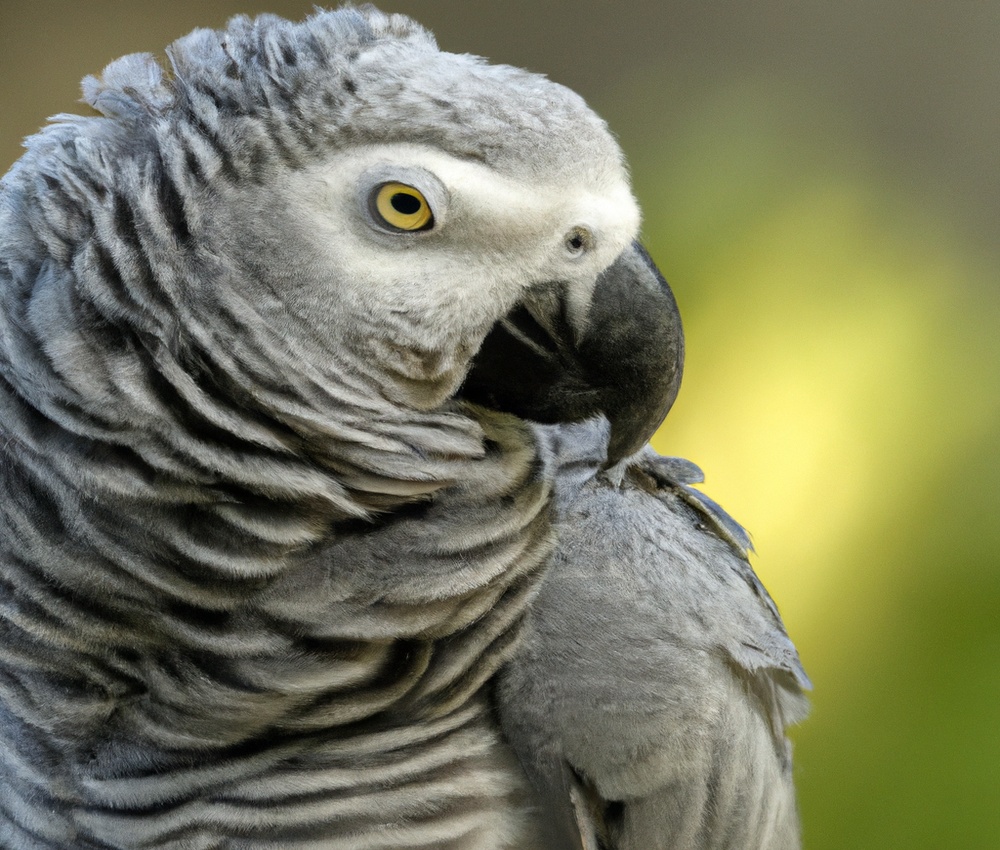
Teaching Your African Grey Parrot to Mimic Sounds
When teaching your African Grey Parrot to mimic sounds, start by using clear and repetitive words or phrases.
Speak to your parrot in a calm and gentle tone and be patient.
Encourage your parrot by offering treats or praise when it repeats a sound correctly.
Use positive reinforcement and repetition to reinforce the desired behavior.
Gradually introduce more complex words or phrases and practice regularly to build your parrot’s vocabulary.

Introducing Simple Words and Phrases
Introducing simple words and phrases is an essential step in training your African Grey Parrot to talk.
Start by choosing words or phrases that are familiar to your parrot, such as their name or a common greeting.
Repeat these words consistently, with clear pronunciation and enthusiasm.
Use positive reinforcement, like treats or praise, when your parrot attempts to repeat the words.
It’s helpful to create a calm and distraction-free environment during these practice sessions.
Be patient, as it may take time for your parrot to understand and mimic the words.
Consistency and repetition are key!
Techniques for Teaching Words and Phrases
To teach your African Grey Parrot to talk, focus on techniques like repetition and consistency, positive reinforcement and rewards, and incorporating contextual learning.
Utilizing Repetition and Consistency
Utilizing repetition and consistency is key when training your African Grey Parrot to talk.
By repeating words and phrases consistently, you help your parrot develop a strong association and understanding of those specific sounds.
Use a clear and distinct voice when saying words, and repeat them frequently throughout the day.
Consistency is important to reinforce and solidify your parrot’s learning.
Incorporate regular training sessions into your daily routine for optimum results.
Using Positive Reinforcement and Rewards
Using positive reinforcement and rewards is a highly effective technique for training your African Grey Parrot to talk. It’s all about associating words and phrases with positive experiences to encourage repetition.
Here’s how you can do it:
- Start by choosing a few key words or phrases that you want your parrot to learn.
- Whenever your parrot says one of these words or phrases, immediately reward them with a treat, praise, or attention.
- Consistency is key! Repeat this process every time your parrot speaks the desired words.
- Gradually increase the difficulty by introducing new words and phrases while still reinforcing the previously learned ones.
- Don’t forget to be patient and provide plenty of encouragement. Positive reinforcement is about making the learning experience enjoyable for your parrot.
By using positive reinforcement and rewards, you create a positive and motivating environment for your African Grey Parrot to learn and speak.
Incorporating Contextual Learning
Incorporating contextual learning is an effective way to train your African Grey Parrot to talk.
Instead of teaching words and phrases in isolation, try using them in relevant situations.
For example, say “hello” when you greet your parrot or “goodbye” when you leave the room.
By connecting words to their meanings, your parrot will start to understand and imitate them more easily.
Additionally, using visual cues and repetition can further enhance their learning experience.
So, try incorporating context to make the training process more engaging and efficient!
Troubleshooting Common Issues
Having trouble with your African Grey Parrot’s speech training? Here are some solutions to common issues.
Overcoming Shyness and Fear
Overcoming shyness and fear in African Grey Parrots can be achieved through gradual exposure and positive reinforcement.
Start by creating a calm and safe environment for your parrot.
Then, introduce new objects, sounds, and people in a slow and controlled manner.
Reward your parrot’s brave behavior with treats and praise to build their confidence.
Repeat these interactions regularly, allowing your parrot to gradually overcome their shyness and fear.
Patience and consistency are key.
Dealing with Picking up the Wrong Words or Sounds
Dealing with your African Grey Parrot picking up the wrong words or sounds can be a challenge, but there are some strategies that can help. Firstly, avoid using any words or sounds you don’t want your parrot to learn.
Instead, focus on consistently using the words or sounds you want them to pick up.
Repetition is key, so consistently reinforce those preferred words or sounds. Secondly, positively reinforce correct words or sounds with treats or praise.
Finally, be patient and consistent with your training.
It may take time for your parrot to learn and differentiate the right words or sounds, but with perseverance, they will get there.
Addressing Vocalization Frustration
Addressing Vocalization Frustration Vocalization is a natural behavior for African Grey Parrots, but it can sometimes become frustrating for their owners. Here are a few tips to help address vocalization frustration:
- Understand their needs: Parrots vocalize to communicate, seek attention, or express boredom. Identifying their needs can help you respond appropriately.
- Provide mental stimulation: Engage your parrot with toys, puzzles, and interactive activities to keep their mind occupied and reduce excessive vocalization.
- Establish a routine: Parrots thrive on consistency, so maintaining a regular feeding, play, and sleep schedule can help minimize vocalization.
- Positive reinforcement: Reward desired behaviors, such as quiet periods, with treats or praise. This can encourage your parrot to associate silence with positive outcomes.
- Seek professional advice: If vocalization persists or becomes problematic, consult an avian veterinarian or a qualified bird behaviorist for further guidance specific to your parrot’s needs.
Remember, each parrot is unique, so finding the right approach may take time and patience.
Enriching Your Parrot’s Vocabulary
To enrich your parrot’s vocabulary, you can use word association techniques and teach them the meanings of different words. Additionally, you can incorporate advanced words and sentences to further expand their language skills.
Expanding Word Repertoire with Word Association
Expanding your parrot’s word repertoire can be achieved through word association.
It’s a simple yet effective technique.
Start by associating a specific word with an action or object.
Repeat the word whenever the action or object is present.
Your parrot will pick up on the association and start using the word appropriately.
For example, say “hello” whenever you greet your parrot.
Soon enough, your feathered friend will start saying “hello” back to you! Keep practicing and be patient – repetition is key.
Teaching Your African Grey Parrot to Understand Meanings
Teaching your African Grey Parrot to understand meanings is an important step in their language development.
Here’s how you can do it:
- Start small: Begin by teaching simple words like “hello” or “goodbye” using repetition and positive reinforcement. Gradually introduce more complex words and phrases.
- Context is key: Use gestures, facial expressions, and objects to help your parrot associate words with their meanings. For example, use a toy when saying “play” or point to a treat when saying “eat”.
- Be consistent: Use the same words and phrases consistently so your parrot can make the connection between the word and its meaning. Repeat them often throughout the day.
- Reinforce with rewards: Positive reinforcement, such as treats or praise, can motivate your parrot to learn and understand meanings faster. Reward them when they respond correctly.
- Patience is key: Teaching your parrot to understand meanings takes time and patience. Be consistent, use repetition, and celebrate small victories along the way.
Incorporating Advanced Words and Sentences
Incorporating advanced words and sentences is a great way to further enrich your African Grey Parrot’s vocabulary. Here are some tips to help you in this process:
- Start with familiar words: Begin by introducing advanced versions of words your parrot already knows. For example, if they know the word “hello,” you can teach them to say “greetings” or “salutations.”
- Be patient: Learning new words and sentence structures takes time. Make sure to practice regularly and be consistent with your training sessions.
- Use context: When introducing new words or sentences, provide context so your parrot can understand their meaning. For instance, if you’re teaching them the phrase “I love you,” say it when expressing affection towards them.
- Expand sentence complexity: Once your parrot has a good grasp of individual words, start incorporating more complex sentences. For instance, instead of just saying “want apple,” teach them to say “I want an apple, please.”
- Reinforce positive behavior: Always reward your parrot with praise, treats, or attention when they successfully use advanced words or sentences. This positive reinforcement will encourage them to continue learning.
Remember, each parrot learns at its own pace, so be patient and have fun with the training process. With consistent practice and positive reinforcement, your African Grey Parrot will continue to expand its vocabulary and amaze you with its linguistic abilities.
Maintaining and Reinforcing Talking Skills
To maintain and reinforce your African Grey Parrot’s talking skills, consistency in training and practice is key.
Engaging in regular interaction and conversations, as well as continuing to challenge and stimulate their learning, will also help enhance their talking abilities.
Consistency in Training and Practice
Consistency in training and practice is essential for teaching your African Grey Parrot to talk.
Here are some tips:
- Set a regular training schedule: Establish a specific time each day to work on talking skills with your parrot. This consistency will help them focus and learn more effectively.
- Use repetitive phrases: Choose a few key phrases or words you want your parrot to learn and repeat them consistently during training sessions. Hearing the same phrases repeatedly will help them associate the words with their meanings.
- Be patient: Training a parrot to talk takes time and repetition. Stay consistent with your training efforts, even if progress is slow. Celebrate small victories along the way to keep yourself and your parrot motivated.
- Create a positive environment: Ensure that your parrot feels comfortable and safe during training sessions. Use positive reinforcement, such as offering treats or praise, to encourage their progress and keep them engaged.
- Practice regularly: Consistency goes beyond just training sessions. Encourage your parrot to practice their talking skills throughout the day by having short interactions and conversations. This continued practice will reinforce their learning and help them retain their vocabulary.
By maintaining consistency in your training and practice efforts, you will increase the likelihood of success in teaching your African Grey Parrot to talk.
Remember, every parrot learns at their own pace, so be patient and enjoy the journey together!
Engaging in Regular Interaction and Conversations
Engaging in regular interaction and conversations is essential for training your African Grey Parrot to talk.
Here are a few tips:
- Talk to your parrot daily: The more your parrot hears human speech, the more likely it is to mimic and learn new words. Have conversations with your parrot throughout the day.
- Use positive reinforcement: When your parrot makes an effort to talk or mimics words, reward them with praise, treats, or attention. This will motivate them to continue speaking.
- Be patient and consistent: Learning to talk takes time for African Grey Parrots. Be patient with your parrot and continue practicing regularly. Consistency is key to their learning process.
- Use a variety of words and phrases: Teach your parrot a range of words and phrases. Start with simple, repetitive words and gradually introduce more complex ones. Repeat them frequently to reinforce the learning.
- Mimic your parrot: Encourage your parrot by mimicking their sounds and words. This will establish a back-and-forth interaction and strengthen their desire to communicate.
- Provide a stimulating environment: African Grey Parrots are intelligent birds who thrive on mental stimulation. Offer them toys, puzzles, and interactive games to keep their minds engaged.
Remember, each parrot is unique and may learn at its own pace.
Engaging in regular interaction and conversations will create a positive learning environment for your African Grey Parrot to develop its talking skills.
Continuing to Challenge and Stimulate Your Parrot’s Learning
Continuing to challenge and stimulate your African Grey Parrot’s learning is vital for their ongoing development.
Here are a few techniques you can use:
- Introduce new words and phrases regularly. Expand their vocabulary by teaching them new words in a consistent and structured manner.
- Engage in interactive activities. Play games like object recognition and retrieval to keep their minds active and encourage problem-solving skills.
- Provide enrichment toys and puzzles. These will not only occupy their time but also stimulate their learning instincts.
- Offer a variety of stimuli. Different visual and auditory experiences will help keep your parrot engaged and prevent boredom.
- Use positive reinforcement. Reward your parrot with treats, praise, and attention when they successfully complete a task or learn something new.
- Practice repetition. Continually reinforce previously learned words and phrases to maintain their language skills.
Remember, each parrot is unique, so observe their preferences and adjust your approach accordingly.
By continuing to challenge and stimulate your parrot’s learning, you can foster a happy and intellectually fulfilled pet.
Additional Tips and Considerations
Gradual Progression and Patience
Training your African Grey Parrot to talk requires gradual progression and patience. Start by introducing simple words and phrases, consistently repeating them to your parrot.
Over time, increase the complexity of the words and length of the phrases.
Reward your parrot with treats and praise when they mimic or attempt to say the words. Remember to be patient, as it takes time for them to learn and develop their talking skills.
Celebrate every small achievement along the way and avoid rushing the process.
Balancing Talking Training with Other Aspects of Parrot Care
Balancing talking training with other aspects of parrot care is essential to ensure the overall well-being of your African Grey Parrot. Here are some tips to help you find the right balance:
- Time management: Dedicate specific time slots for talking training while also allocating time for socialization, exercise, and mental stimulation.
- Multifaceted approach: Besides training your parrot to talk, focus on providing a varied and enriching environment. Offer toys, puzzles, and opportunities for foraging to keep them engaged.
- Healthy diet: Proper nutrition is crucial for your parrot’s health. Ensure they have a balanced diet of fresh fruits, vegetables, pellets, and occasional treats.
- Veterinary care: Regular check-ups with an avian veterinarian are vital. They can provide guidance on nutrition, detect health issues early on, and offer advice on parrot care.
- Emotional well-being: African Grey Parrots are highly intelligent and social creatures. Spend quality time with your parrot, engage in interactive play, and provide opportunities for social interaction with both humans and other parrots.
By finding the right balance between talking training and other aspects of parrot care, you can create a well-rounded and fulfilling life for your African Grey Parrot.
Frequently Asked Questions
How long does it typically take to train an African Grey Parrot to talk?
Training an African Grey Parrot to talk depends on several factors, such as the individual bird’s personality and environment. Some parrots may start talking within a few weeks, while others may take several months or even longer.
Consistency, patience, and positive reinforcement are key to successful training.
It’s important to spend quality time with your parrot, engage in interactive conversations, and use repetition and rewards to encourage speech. Keep in mind that not all African Grey Parrots will talk, as it is a skill that varies among individuals.
Can parrots of all ages be trained to talk?
Parrots of all ages can be trained to talk.
It is a common misconception that only young parrots can learn to talk.
In reality, parrots have the ability to mimic sounds and learn words throughout their entire lives.
The key to successful training lies in consistency, patience, and positive reinforcement.
By providing regular training sessions and using rewards, such as treats or praise, you can help your parrot develop a vocabulary and communicate with you.
Start with simple words and phrases, and gradually increase the complexity as your parrot progresses.
With time and effort, any parrot can become a skilled talker.
My parrot already mimics sounds but doesn’t seem to understand words. What should I do?
If your parrot is already mimicking sounds but doesn’t seem to understand words, there are a few things you can try.
First, make sure you’re using consistent and clear cues when you want your parrot to learn a specific word.
Second, try using visual aids or gestures to reinforce the meaning of the words.
Third, be patient and consistent in your training efforts, as it may take time for your parrot to fully understand and respond to words.
Don’t forget to reward and praise your parrot when they make progress!
Final Verdict
Training your African Grey Parrot to talk is an exciting and rewarding journey that requires patience, consistency, and a positive environment.
By establishing trust, providing a stimulating environment, and using techniques like repetition and positive reinforcement, you can teach your parrot to mimic sounds, understand words, and even engage in conversations.
Remember to address common challenges, enrich their vocabulary, and maintain consistency in training and practice.
And if you encounter difficulties, seek professional help.
With dedication and love, you can unlock the full potential of your African Grey Parrot’s vocal abilities and create a lifelong bond.


